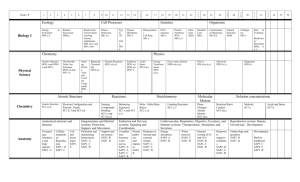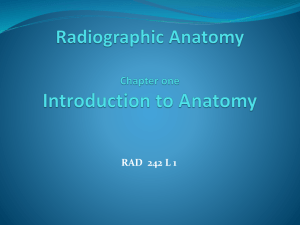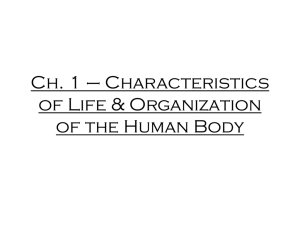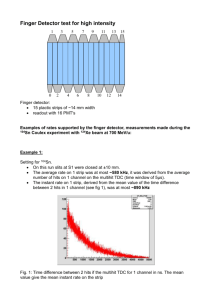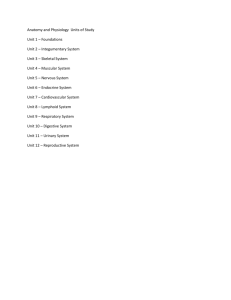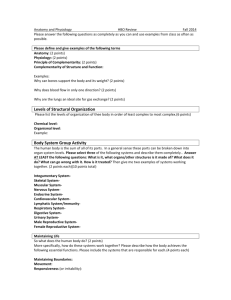1st Nine Weeks Lesson Plans
advertisement
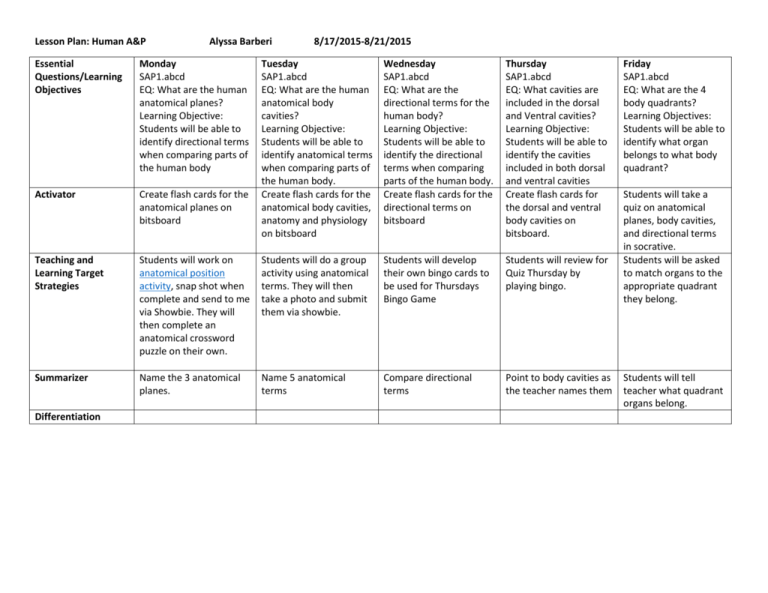
Lesson Plan: Human A&P Alyssa Barberi Essential Questions/Learning Objectives Monday SAP1.abcd EQ: What are the human anatomical planes? Learning Objective: Students will be able to identify directional terms when comparing parts of the human body Activator Create flash cards for the anatomical planes on bitsboard Teaching and Learning Target Strategies Summarizer Differentiation 8/17/2015-8/21/2015 Tuesday SAP1.abcd EQ: What are the human anatomical body cavities? Learning Objective: Students will be able to identify anatomical terms when comparing parts of the human body. Create flash cards for the anatomical body cavities, anatomy and physiology on bitsboard Wednesday SAP1.abcd EQ: What are the directional terms for the human body? Learning Objective: Students will be able to identify the directional terms when comparing parts of the human body. Create flash cards for the directional terms on bitsboard Thursday SAP1.abcd EQ: What cavities are included in the dorsal and Ventral cavities? Learning Objective: Students will be able to identify the cavities included in both dorsal and ventral cavities Create flash cards for the dorsal and ventral body cavities on bitsboard. Students will work on anatomical position activity, snap shot when complete and send to me via Showbie. They will then complete an anatomical crossword puzzle on their own. Students will do a group activity using anatomical terms. They will then take a photo and submit them via showbie. Students will develop their own bingo cards to be used for Thursdays Bingo Game Students will review for Quiz Thursday by playing bingo. Name the 3 anatomical planes. Name 5 anatomical terms Compare directional terms Point to body cavities as the teacher names them Friday SAP1.abcd EQ: What are the 4 body quadrants? Learning Objectives: Students will be able to identify what organ belongs to what body quadrant? Students will take a quiz on anatomical planes, body cavities, and directional terms in socrative. Students will be asked to match organs to the appropriate quadrant they belong. Students will tell teacher what quadrant organs belong. Lesson Plan : Human A&P Ms. Barberi Essential Questions/Bell Ringer/Learning Objectives Monday EQ: What are the 11 organ systems? Learning Objective: Students will learn about the 11 organ systems, parts, and basic functions of each. Activator On bitsboard add organ system, the 11 systems, definitions, and photos. Teaching and Learning Target Strategies Watch video Human Anatomy and Physiology: Organ Systems 8/24/2015-8/28/2015 Standards: SAP1.abcd Tuesday EQ: What are the integumentary, skeletal, muscular, and lymphatic systems responsible for? Learning Objective: Discuss the characteristics of life/necessary life finctions. On bitsboard add movement, responsiveness, growth, reproduction, respiratory, digestion, absorption, circulation, assimilation, and excretion and their definitions. Finish watching video Human Anatomy and Physiology: Organ Systems Wednesday EQ: What are the respiratory, digestive, nervous, and endocrine systems responsible for? Learning Objective: Go over the levels of structural organization of the human body. Thursday EQ: What are the cardiovascular, urinary, female reproductive, ad male reproductive systems responsible for? Learning Objective: Discuss and understand how homeostasis works. Friday EQ: What are the levels of structural organization in order from smallest to largest? Learning Objective: Discuss the levels of structural organization. Create a poster with the levels of structural organization in order. Include name, description, and picture. Send to me via Showbie. Can be done on paper or on an app of your choice. On bitsboard define homeostasis, receptor, control center, effector, negative feedback mechanism, and positive feedback system from page 12-13 in anatomy book. Complete socrative quiz on body systems, characteristics of life, homeostasis, and structural organization. Watch video on Introduction to Anatomy Physiology: levels of Organization Watch video on Human Anatomy and Physiology: Homeostasis Watch video and take notes on Homeostasis in the Human Body [3D Animation] Complete fill in notes Students take own notes What organ system is responsible for excreting waste from our body that has been took in from the kidneys? List the levels of organization from largest to smallest Complete fill in notes. Summarizer Differentiation What organ system is responsible for regulating temperature? Students complete fill in notes What is homeostasis responsible for? Students complete fill in notes Why is it important for us to eat healthy and not unhealthy? Lesson Plan : Human A&P Ms. Barberi Day Standard: Essential Questions/Bell Ringer/Learning Objectives Monday SAP1.abcd EQ: What organ system is responsible for the immune system? Learning Objective: Review Unit one Vocabulary Activator Play Directional Terms Matching game. Teaching and Learning Target Strategies Matching Vocabulary terms to Definitions. Summarizer Differentiation Give me an example of all 10 directional terms. 8/31-9/4/2015 Tuesday SAP1.abcd EQ: What organ is responsible for regulating blood pH? Learning Objective: Review Unit One Directional Terms, Anatomic positon, and Organ systems. Play Human Body Arcade Game. Complete Online Anatomical quiz for preparation of Friday Test Name and organ in each body cavity. Wednesday SAP1.abcd EQ: What is the difference between anatomy and physiology? Learning Objective: Review Dissection Terminology Thursday SAP1.abcd EQ: Why is homeostasis important? Learning Objective: Review homeostasis terminology Friday SAP1.abcd EQ: Why is anatomic positon important? Learning Objective: Unit one test. Begin Unit 2 Vocabulary Play Dissection Terminology Scatter game Complete Online Anatomical Quiz for preparation of Friday Test Name all 4 planes. Play Homeostasis game Last minute study time. Watch Video to Review Anatomical Planes Review for test tomorrow What is homeostasis? Test Begin Unit 2 Vocabulary What are the necessary functions of life? Lesson Plan : Human A&P Essential Questions/Bell Ringer/Learning Objectives Activator Teaching and Learning Target Strategies Summarizer Differentiation Monday Ms. Barberi 9/8-9/11/2015 Standards: SAP1.abcd Tuesday EQ: What is the smallest unit of matter? What is the organization of life from smallest to largest Learning Objective: Students will be able to correctly match definitions to their terms Wednesday EQ: What is an atom and why is it important for life? Learning Objective: Students will learn about basic biochemistry and how it relates to the human body Thursday EQ: How does vitamin deficiency affect the human body? Learning Objective: Students will learn about basic biochemistry and how it relates to the human body Friday EQ: Why is hydrogen bonding important? Learning Objective: Students will be ale to correctly identify bonding factors of different elements and why they are important for the human body Complete worksheet on showbie Click on showbie and send me any questions you have on the test we took Friday. Students will work on vocabulary foldable to introduce them on important terminology for the next unit. Click on Quizlet help link for assistance Why is the organization of life important? Complete vocabulary activity on showbie. Students will complete notes on first half of Unit 2 Basic Biochemistry video Students will complete notes on second half of Unit 2 Basic Biochemistry video Students will complete an activity on macromolecules. How do hydrogen bonds occur? What are the 4 macromolecules? Why are macromolecules important for the human body? Lesson Plan : Human A&P Ms. Barberi 9/14/2015-9/18/2015 Essential Questions/Bell Ringer/Learning Objectives Monday EQ: What are the 4 macromolecules? Learning Objective: Understand the importance of macromolecules and enzymes, and how they function to help our body. Tuesday EQ: What are enzymes made of? Learning Objective: Understand the importance of macromolecules and enzymes, and how they function to help our body. Activator What are the most common elements for living things? Students will apply knowledge from last week and complete a worksheet on macromolecules and enzymes. How do macromolecules help our body function? What do amino acids contain? Work in partners Work in partners Teaching and Learning Target Strategies Summarizer Differentiation Students will apply knowledge from last week and complete a worksheet on macromolecules and enzymes. How do enzymes function in our body? Standards: SAP1.abcd Wednesday EQ: What is the difference between a monosaccharide and a polysaccharide? Learning Objective: Students will be able to correctly identify macromolecules and tell me the importance of them for the human body. What is the cell membrane composed of? Students will complete a quiz and worksheet pertaining to biochemistry. What do Carbohydrates, Proteins, Lipids, and Nucleic Acids help our body function? Work in partners Thursday EQ: How does vitamin deficiency affect the human body? Learning Objective: Students will learn about basic biochemistry and how it relates to the human body Friday EQ: Why is biochemistry important to the human body? Learning Objective: Students will take a test on Biochemistry and how it applies to our body What is the difference between Saturated and unsaturated fats? Students will complete a review for test tomorrow Review for test What is the importance of enzymes in the human body? Become familiar with vocabulary terms Work in partners Work in partners Students will take a test on biochemistry. Pass out vocabulary for next chapter. Lesson Plan : Human A&P Ms. Barberi 9/21-9/25/2015 SAP.1e Describe how structure and function are related in terms of cell and tissue types? Standard: Bell Ringer Monday SAP1.e What are the 4 primary elements for life? Tuesday SAP1.e What is the relationship between cells and tissues? Essential EQ: How are cells EQ: What is the function Questions/Learning important for the human of a cell, organelle and Objectives body inclusion? Learning Objective: Learning Objective: Students will have a brief Students will be overview of the Cellular introduced to the Basis of Life and Anatomy vocabulary to be used of a Generalized cell. during this Unit. Focusing on the nucleus Activator What are the levels of structural organization from smallest to largest? Teaching and Learning Target Strategies Students will complete fill in the blank notes on video Organelles of the Cell Summarizer Name 5 parts of the cell? Differentiation Small group work Name the 4 elements that make up the bulk of living matter and list several trace elements. Students will complete fill in the blank notes on video Organelles of the Cell What percent of living cells is water? What is the general function of the nucleus? Visual, Audio, Kinesthetic Partner Work Wednesday SAP1.e What is the difference between anatomy and physiology? EQ: What are phospholipids, proteins, and cholesterol responsible for in the cell? Learning Objective: Students will learn about Anatomy of a Generalized cell. Focusing on the plasma membrane What are the 3 main regions or parts of the cell? Thursday SAP1.e What are the 8 necessary life functions? Pass out vocab foldable for this unit to be completed during class. Vocab website Students will watch a video and complete fill in the blank notes. Which Organelle is the major site of ATP synthesis? What are the two types of transportation inside and out of the cell? Take a quiz in socrative over the Cellular Basis of life and Anatomy of a Generalized cell. Students will go over the 7 Cell Diversity types and complete a set of notes and take home a worksheet to be completed over the weekend. Name the two cell types involved in connecting body part or regions. Visual, Audio, Kinesthetic Partner Work Visual, Audio, Kinesthetic Partner Work Visual, Audio, Kinesthetic Partner Work EQ: How do the cytosol and the cytoplasm differ? Learning Objective: Students will learn about Anatomy of a Generalized cell. Focusing on the cytoplasm. What is hydrophilic and hydrophobic? Friday SAP1.e What are the 5 survival needs we need to stay alive? EQ: What are the 7 types of cell specialists? Learning Objective: Students will learn about cell diversity and how different types of cells function. Lesson Plan : Human A&P Ms. Barberi 9/28-10/2/2015 SAP.1de Relate cellular metabolism and transport to homeostasis and cellular reproduction. Describe how structure and function are related in terms of cell and tissue types. Standard: Bell Ringer Monday SAP1.de What organelle is responsible for making proteins? Essential EQ: How are materials Questions/Learning transported into and out Objectives of the cell? Learning Objective: Students will have a brief overview of cell membrane transport. Tuesday SAP1.de What is passive transport? Wednesday SAP1.de What is active transport? Thursday SAP1.de What is the difference between Hypertonic, Isotonic, and Hypotonic? EQ: How do the cytosol and the cytoplasm differ? Learning Objective: Students will review over parts of the cell and membrane transport. Friday SAP1.de What are the 5 survival needs we need to stay alive? EQ: What is the importance of membrane transportation? Learning Objective: Students will test over Membrane transport and organelles. EQ: How are materials transported into and out of the cell? Learning Objective: Students will be introduced to the vocabulary to be used during this Unit. Define diffusion and osmosis. EQ: Learning Objective: Students will learn about Anatomy of a Generalized cell. Focusing on the plasma membrane What is concentration gradient? What is endocytosis (include both types) and Exocytosis? Take a quiz in socrative over the Cellular Basis of life and Anatomy of a Generalized cell. Students will take a test pertaining to parts of the cell and membrane transport. Activator List 4 organelles that lie and the cytoplasm and a brief description of each. Teaching and Learning Target Strategies Students will complete fill in the blank notes on Nearpod about cell membrane transport Students will watch a short video and complete an activity on membrane transportation Students will complete an activity on membrane transport and begin working on review for test. Students will complete a short review for test tomorrow Summarizer What is concentration gradient? What is facilitated diffusion? What is a protein pumps function? Differentiation Small group work Visual, Audio, Kinesthetic Partner Work Visual, Audio, Kinesthetic Partner Work What are the two types of transportation inside and out of the cell? Visual, Audio, Kinesthetic Partner Work Have an awesome fall break. Lesson Plan : Human A&P Ms. Barberi 10/12-10/16/15 SAP.1de Relate cellular metabolism and transport to homeostasis and cellular reproduction. Describe how structure and function are related in terms of cell and tissue types. Standard: Bell Ringer Monday SAP1.de What are the monomers that deal with each Macromolecule? Essential EQ: What are the 4 Questions/Learning macromolecules Objectives Learning Objective: Students will take a retest over Basic Biochemistry. Students will also begin their unit on Tissue types and cellular reproduction. Activator Study your review for test Teaching and Learning Target Strategies Students will complete a test on Macromolecules and Enzymes. Begin studying cellular reproduction and tissue types. What is cellular reproduction? Test and individual work. Summarizer Differentiation Tuesday SAP1.de Wednesday SAP1.de What is the cell life cycle? What is mitosis? Thursday SAP1.de What is Cytokinesis? EQ: What are the terms you need to know that deal with cellular reproduction and tissue types? Learning Objective: Students will be introduced to the vocabulary to be used during this Unit. Define mitosis and cytokinesis EQ: What are the events of cell division? Learning Objective: Students will learn about the phases of cell reproduction. EQ: What is the blueprint for protein synthesis? Learning Objective: Students will cover material over protein synthesis and how DNA is reproduced. What is the purpose of cell reproduction? What is an enzyme? Students will complete vocabulary activity on this unit. Students will complete notes on cellular reproduction. Students will complete a notes on protein synthesis. What are the 4 phases of mitosis? Visual, Audio, Kinesthetic Partner Work What is cytokinesis? What is transcription? Visual, Audio, Kinesthetic Partner Work Visual, Audio, Kinesthetic Partner Work Friday SAP1.de What is the difference between transcription and translation? EQ: What is the role of RNA? Learning Objective: Students will take a quiz over cell reproduction. Students will then begin their study on cell and tissue types Take a quiz in socrative over the Cellular Basis of life and Anatomy of a Generalized cell. Students will begin notes on tissue and cell types. What is epithelium tissue? Visual, Audio, Lesson Plan : Human A&P Ms. Barberi 10/19-10/23/2015 SAP.1de Relate cellular metabolism and transport to homeostasis and cellular reproduction. Describe how structure and function are related in terms of cell and tissue types. Standard: Bell Ringer Monday SAP1.de What occurs during interphase? Essential EQ: What is important Questions/Learning for each stage of mitosis? Objectives Learning Objective: Students will review and complete worksheet on Cell Division. Tuesday SAP1.de What is the difference between phagocytosis and pinocytosis? EQ: What is the role of RNA? Learning Objective: Students will take a quiz over cell reproduction. Students will then begin their study on cell and tissue types Take a quiz in socrative over Interphase and Mitosis Students will begin notes on Protein Synthesis. Wednesday SAP1.de What is the difference between transcription and translation? EQ: What is a codon? Learning Objective: Students will cover material over protein synthesis and how DNA is reproduced. Thursday SAP1.de What is an anticodon? Friday SAP1.de What is epithelium tissue? EQ: What two criteria are used to classify epithelial tissues? Learning Objective: Students will learn about tissue types of the human body EQ: What are the special classifications of epithelium? Learning Objective: Studens will learn about tissue types of the human body What is the difference between Transcription and translation? Students will complete worksheet on Protein synthesis What are the responsibilities of RNA during protein synthesis? Students will complete a notes on Tissue types? What are the 5 classifications of epithelia? Students will complete a notes on Tissue types? What occurs during the translation phase of protein synthesis? Visual, Audio, Kinesthetic Partner Work What is the epithelium? What is epithelium tissue? Visual, Audio, Kinesthetic Partner Work Visual, Audio, Activator What occurs during cytokinesis? Teaching and Learning Target Strategies Students will complete worksheet on Cell Division Summarizer What is cell division? What is a gene? Differentiation Partner work. Visual, Audio,

